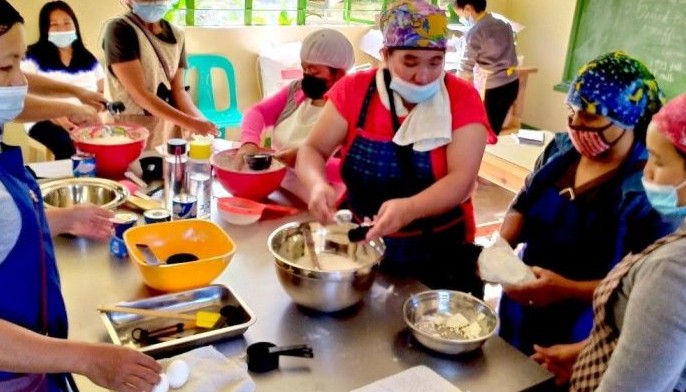MANILA, Philippines — Despite being touted as a swift route to employment after high school, technical vocational programs still yield graduates who mostly end up in minimum wage jobs.
While the Technical Education and Skills Development Authority (TESDA) recently boasted an 80% employment rate among graduates, data shows that most earn lower than the average monthly minimum wage — or around P13,420 to P15,860.
A Philstar.com analysis also shows that wages of TESDA graduates fall far below the “family living wage” set by economic think-tank IBON Foundation and the government-set poverty line, underscoring the poor job market awaiting those who take the tech-voc route.
Based on 2021 data, TESDA graduates who complete their training earn an average of P11,000 monthly.
Those who complete National Certificates 3 and 4 — the highest level of certification issued by TESDA — earn only about P12,926 on average, which is still short of the lower-end of the average monthly minimum wage.
A National Certificate is issued when a TESDA graduate has completed a course and serves as official proof of their mastery of a skill or competency when applying for jobs locally and abroad.
In comparison, IBON Foundation estimated that each family in the National Capital Region would need P25,327 per month to provide for all expenditures and keep a standard of living above subsistence level.
Meanwhile, the PSA set the poverty threshold — or the minimum wage a worker should to stay above the poverty line and provide the needs of a family of five — at P12,030 monthly, as of 2021.
From 2010 to 2014, TESDA graduates earned only around P10,000 per month on average, according to the National Technical Education and Skills Development Plan (NTESDP) 2018 to 2022.
RELATED: Desire for new skills drives Filipinos to enroll in TESDA courses
Ticket out of poverty?
During the Senate's hearing on TESDA's proposed P15.2-billion budget for next year, Sen. Joel Villanueva, said that the agency must find a way to improve the job prospects of TESDA graduates.
“If this trend will continue to go on, we’re only allowing them to land jobs below minimum wage and there's no way that we can help them to get out of poverty,” said the former TESDA chief and commissioner of the Second Congressional Commission on Education (EDCOM 2).
Sen. Sherwin Gatchalian said: “We gave them NC 1, NC 2, they wasted their time going to TESDA, [attending Senior High School], but the jobs that they are landing are below minimum wage. So that's not commensurate to the time they spent.”
“Eight out of 10 employment—we should not be happy with that. But with eight out of ten who are employed and earning above minimum wage, then we will be very happy to see that,” the EDCOM 2 co-chairperson said.
Latest data from the Philippine Statistics Authority show that more Filipinos are looking for additional income streams on top of their 40-hour work week as underemployment rose to 15.9% in July from 12% in June and 13.8% in July last year.
Trade Union Congress of the Philippines Vice President Luis Corral said on Monday that the government must look beyond the “poverty trap” of low-quality jobs and focus on creating decent work.
“(There) is an urgent need for the (Department of Labor and Employment), as part of the government’s economic team, to go beyond mere job facilitation, such as job fairs, towards partnership, with the Department of Trade and Industry and the Department of Public Works and Highways, to develop a public employment program,” Corral said.
“We cannot simply and solely rely on the reopening of the economy and depend on the private sector for job creation,” he added.
RELATED: Senior high graduates not job-ready? Senator points out government’s own lapses in hiring | Senior high graduates more likely to earn higher wages than junior high graduates — study
EDCOM 2 bats for better assessment, certification
Gatchalian also expressed concerns over the low assessment rate for TESDA graduates, with only around 900,000 students assessed out of the 1.2 million who graduated from TESDA programs from 2018 to 2022.
TESDA assessments refer to the evaluation and testing processes conducted to determine the skills of individuals who have completed technical vocational education and training programs. Successful completion of these assessments leads to the issuance of a TESDA National Certificate.
TESDA officials explained that there are a number of programs where there are no training regulations yet, which are required to create competency assessment tools for a particular program.
Some programs were allowed even without training regulations because they are in demand, TESDA officials added.
Villanueva and Gatchalian also questioned the lower targets set by the agency for the assessment of graduates.
Under the 2024 National Expenditure Plan (NEP), the baseline of TESDA is 80%. However, the 2023 target is 70%, and the 2024 target is 60%.
In previous meetings, EDCOM 2 members in the Senate also pushed for the assessment and certification of senior high school students who are under the technical-vocational-livelihood (TVL) track.
An analysis by EDCOM 2 shows that the government would have to shell out P1 billion in the proposed 2024 budget to cover the assessment and certification of SHS-TVL students.


